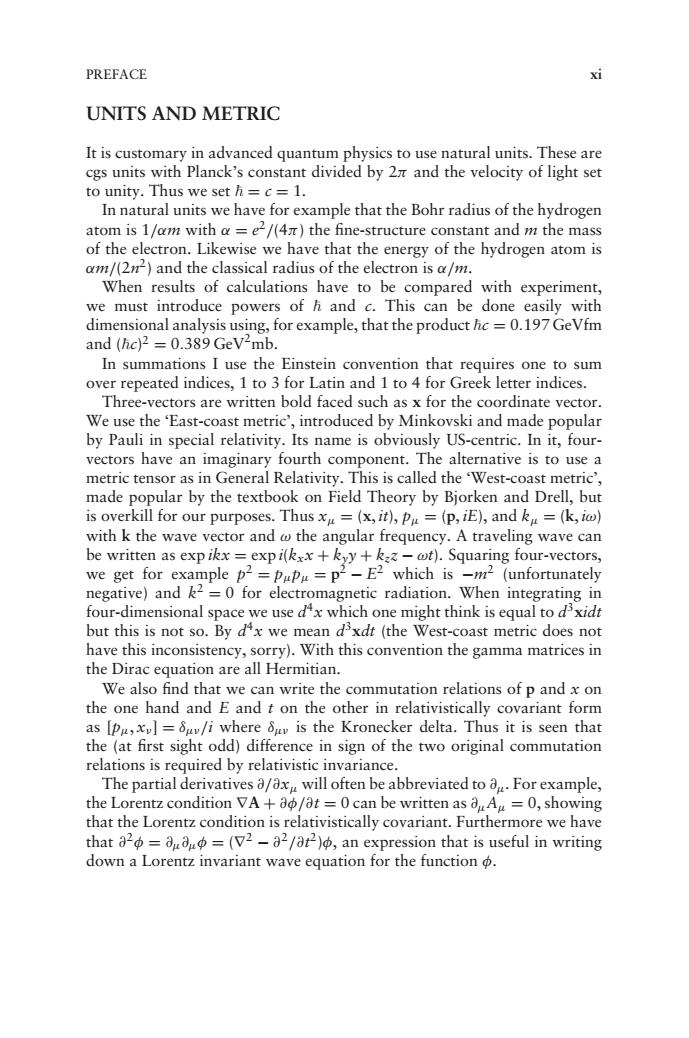正在加载图片...

PREFACE 5 UNITS AND METRIC It is customary in advanced quantum physics to use natural units.These are cgs units with Planck's constant divided by 2 and the velocity of light set to unity.Thus we set =c=1. In natural units we have for example that the Bohr radius of the hydrogen atom is 1/am with a=/(4x)th fine-structure constant and m the mass of the electron.Likewise we have that the energy of the hydrogen atom is am/(2n2)and the classical radius of the electron is a/m. When results of calculations have to be compared with experiment, we must introduce powers of h and c.This can be done easily with dimensional analysis u 9GeV-mb g,for example,that the product he=0.197 GeVfm and(hc2=0.3 In summations I use the Einstein convention that requires one to sum over repeated indices,1 to 3 for Latin and 1 to 4 for Greek letter indices. Three-vectors are written bold faced such as x for the coordinate vector. We use the 'East-coast metric',introduced by Minkovski and made popular by Pauli in special relativity.Its name is obviously US-cen tric.In it ,four vectors have an com nent The alte mative is to use ativity. s is called th West-co me made popular by the textbook on Field Theory by Bjorken and Drell,but is overkill for our purposes.Thus=(x,it),pu=(p,iE),and k=(k,iw) with k the wave vector and the angular frequ ency.a traveling wave can be written as e mple 2 expi(kxx+ y+k: )Squaring four-vecto we get for 2 2 unfortunate negative)and -0 for electromagn etic radiation When integratin 1g four-dimensional space we use dx which one might think is equal to dxidt but this is not so.By dx we mean d3xdt(the West-coast metric does not have this inconsistency,sorry).With this convention the gamma matrices in the Dirac equation are all Hermitian. We also find that e can write the mmutation relations of p and x on the one hand and E and t on th e other in relativistic ly covariant form as [pa,=v/i where is the Kronecker delta.Thus it is seen that the (at first sight odd)difference in sign of the two original commutation relations is required by relativistic invariance. The partial derivatives a/ax will often be abbreviated to a.For example the Lor ntz condition VA+/at=0can be written as aA=0,shov ving that the covarian Furtherm re we have that a ==(V-0-/0t-)o,an expression that is useful in writing down a Lorentz invariant wave equation for the functionPREFACE xi UNITS AND METRIC It is customary in advanced quantum physics to use natural units. These are cgs units with Planck’s constant divided by 2π and the velocity of light set to unity. Thus we set = c = 1. In natural units we have for example that the Bohr radius of the hydrogen atom is 1/αm with α = e2/(4π) the fine-structure constant and m the mass of the electron. Likewise we have that the energy of the hydrogen atom is αm/(2n2) and the classical radius of the electron is α/m. When results of calculations have to be compared with experiment, we must introduce powers of and c. This can be done easily with dimensional analysis using, for example, that the product c = 0.197 GeVfm and (c) 2 = 0.389 GeV2mb. In summations I use the Einstein convention that requires one to sum over repeated indices, 1 to 3 for Latin and 1 to 4 for Greek letter indices. Three-vectors are written bold faced such as x for the coordinate vector. We use the ‘East-coast metric’, introduced by Minkovski and made popular by Pauli in special relativity. Its name is obviously US-centric. In it, fourvectors have an imaginary fourth component. The alternative is to use a metric tensor as in General Relativity. This is called the ‘West-coast metric’, made popular by the textbook on Field Theory by Bjorken and Drell, but is overkill for our purposes. Thus xµ = (x, it), pµ = (p, iE), and kµ = (k, iω) with k the wave vector and ω the angular frequency. A traveling wave can be written as exp ikx = exp i(kxx + kyy + kzz − ωt). Squaring four-vectors, we get for example p2 = pµpµ = p2 − E2 which is −m2 (unfortunately negative) and k2 = 0 for electromagnetic radiation. When integrating in four-dimensional space we use d4x which one might think is equal to d3xidt but this is not so. By d4x we mean d3xdt (the West-coast metric does not have this inconsistency, sorry). With this convention the gamma matrices in the Dirac equation are all Hermitian. We also find that we can write the commutation relations of p and x on the one hand and E and t on the other in relativistically covariant form as [pµ, xν ] = δµν /i where δµν is the Kronecker delta. Thus it is seen that the (at first sight odd) difference in sign of the two original commutation relations is required by relativistic invariance. The partial derivatives ∂/∂xµ will often be abbreviated to ∂µ. For example, the Lorentz condition ∇A + ∂φ/∂t = 0 can be written as ∂µAµ = 0, showing that the Lorentz condition is relativistically covariant. Furthermore we have that ∂2φ = ∂µ∂µφ = (∇2 − ∂2/∂t 2)φ, an expression that is useful in writing down a Lorentz invariant wave equation for the function φ